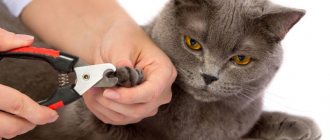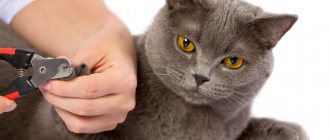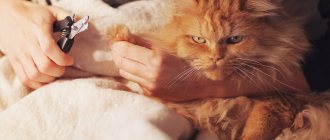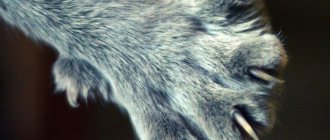Our fluffy and gentle pets have natural reliable protection. These are strong, sharp little claws. They can cause serious injuries to cats, which causes concern for many owners, especially if there are small children in the house. Special microorganisms (Bartonella bacteria) nest on the claws of cats, which, when released into the bloodstream when the skin is damaged, can provoke a disease - felinosis, cat scratch syndrome, benign lymphoreticulosis, cat scratch fever, Mollaret granuloma. Under all these complex and long names lies a very unpleasant infectious disease with inflammation of the lymph nodes, fever and severe intoxication. The disease requires the use of antibiotics for treatment.
Considering the possible health risks, as well as the passionate love of cats for scratching new expensive furniture, fresh wallpaper and expensive carpets, many owners come to the conclusion that something needs to be done about their pet’s claws. In the best case, special scratching posts are purchased for pets; in the worst case, they decide to have their nails cut or completely removed.
Before you make potentially dangerous and cruel decisions, you need to understand why cats need claws and what role they play in their lives.
Inventory
Trimming cats' claws is a regular activity. In pets, the nail plate grows over the course of 2-3 weeks. Artificial manicure is not recommended for yard cats. Scratching serves as protection for them and helps them obtain food.
There are several tools available for trimming cat's claws. They all have scary names, but in fact they make the procedure much easier:
Guillotine shears will allow you to deal with claws in a matter of minutes. You must be extremely careful when using this tool. To avoid damaging blood vessels and causing split nails.
You can buy special pruning shears at a pet store. Professional nail clippers help simplify the procedure and prevent the plate from delaminating. When purchasing pruners, you must carefully study the instructions and also become familiar with the nuances of cutting scratches.
It is not recommended to use ordinary wire cutters or scissors. They can damage the claw, making it difficult for it to grow back later. If there is no other choice, be sure to make sure that the wire cutters are sharp. Better yet, buy a special device.
It is also necessary to disinfect the cutting surface of any of the tools.
After the procedure, it will not be superfluous to trim the cut surface with a nail file.
Can scissors and clippers be used on human nails?
Some cat lovers are interested in whether it is possible to trim claws with regular scissors and, conversely, use a cat nail clipper to trim human nails. It is not recommended to do either one or the other.
Before purchasing, you need to carefully examine your pet's paws. If the claws are small and thin, then you should give preference to nippers, and for large claw plates, a guillotine is suitable. It is equally important that the tool is convenient for the person who will use it.
How to trim claws correctly
In order not to harm your pet by taking care of his manicure, you need to know how to trim a cat’s claws correctly. The owner should remember that the cat will not agree with the need for this procedure, so his task is to conduct a “beauty session” with the least losses on both sides. If the animal is endowed with a bright temperament, it is best to carry out the procedure with several people.
It is easiest to trim light-colored nails. Such a scratch is slightly transparent, so you can clearly see the blood vessel, which in no case should be touched.
If you have to trim black claws, it is better to cut off only the very tip. The procedure will have to be performed more often, but the risk of touching the vessel is minimized.
Before starting, in addition to the tools, you need to prepare hydrogen peroxide and cotton wool. This is necessary in case the claw gets damaged during trimming and begins to bleed.
Before trimming your cat's claws correctly, read these tips:
- First of all, you need to thoroughly wash your hands and disinfect all cutting objects. Next, you should take the animal’s paw in your hand and hold it a little so that the pet does not pull it out of your palm while trimming. Press the paw so that the claw appears. Its base should be visible. There should be enough light to see the blood vessels through and accurately determine the cutting line. It is necessary to trim the claw so that at least 3 mm remains to the pulp. To prevent fractures from forming, the claw is cut from top to bottom. The fifth nail on the inside of the paw should also be shortened slightly. File the tip a little with a nail file so that it doesn’t get caught.
If the cat reacts very violently, before the procedure you can wrap it in a towel, alternately releasing the desired paw. Nail trimming can be divided into stages and treated one paw per day.
Another feature of nail trimming is the hair. Before the procedure, it is necessary to cut the tufts of hair located between the pads. It is better not to use any buzzing machines. They can scare the pet and the idea will not succeed.
Pros and cons of trimmed nails
Some of the benefits of trimming cat claws include:
- Household safety. This is relevant if there are small children in the house who provoke the animal to defend itself. Integrity of furniture.
The disadvantages include the cat’s inability to defend itself when attacked by unfriendly animals. If the cat is used to walking outside, it is better not to trim its scratches. Also, inattentive nail care can expose your cat to infections and diseases of the limbs.
When jumping somewhere higher, the cat relies on its claws. If they are cut, it may fall without finding something to catch on.
It is worth remembering that after cutting their nails, many cats experience real stress. Therefore, the need for the procedure must outweigh the risk of possible complications.
Possible complications after cutting nails
Complications after haircut
Cats are afraid of being groomed, so their behavior is often unpredictable. The pet may begin to break free from your hands and run away. There is a high probability of accidentally touching a nerve ending, and in this case blood may bleed. But there's no need to be nervous. It is important to react in time and provide first aid. There should always be disinfectants in the house. If there is a cut, you need to treat the paw with an antiseptic, anoint it with iodine and sprinkle it with talcum powder.
If the bleeding does not stop for a long time, contact your veterinarian.
How to trim a kitten's claws
When you take a small kitten into your home, you should decide on the problem of claws from the very first days. If you have decided to cut your hair, you need to start getting used to the procedure from an early age. The pet's paws should be taught to touch: when the baby is in your arms, you need to stroke his paws and press on the pads.
Kittens' nails should be trimmed very carefully. You cannot start the procedure when the baby is playful and excited or hungry. It is best to start when the furry is calm or even sleeping. If the baby shows aggression, hisses and bites, there is no point in continuing - postpone the lesson until tomorrow.
The question of whether a cat’s claws need to be trimmed remains relevant for all owners. This procedure has its pros and cons. If the importance of the pros outweighs the cons, trimming the nails will become one of the stages in caring for your pet. The procedure should be carried out according to the rules and regularly. It is equally important to pay attention to your pet's emotional state during grooming, since most cats do not agree to manicure sessions voluntarily.
Video
When we bring a little fluffy ball into the house, we rejoice at it and don’t think about all the difficulties of keeping a cat at home. But in addition to silky fur and clear eyes, the charming purr also has very sharp claws.
Like a human nail, a cat's claws grow throughout their lives. If street cats successfully wear down their length on asphalt or hard ground, or sharpen them on tree trunks, then at home there is often simply no place for animals to do this. And then expensive furniture, leather sofas and valuable upholstery of chairs and armchairs are used. Having played out, the animal can accidentally seriously injure a small child with its claws, and this can lead to unpleasant infections.
In such a situation, owners have to think about what the cat needs at home. This can also be caused by a common problem in domestic cats—an ingrown claw into the pad of the toe. Due to pain, the animal cannot move normally, and the resulting wound can become very inflamed. To prevent this from happening, owners must know how to trim a cat's claws correctly.
Claws as a natural means of attack, defense and a tool for practical use
The ancestors of cats were nocturnal, living in savannas and semi-deserts, spending part of their time in trees. Small, but very tenacious and strong claws in the shape of Turkish scimitars helped them deftly and quickly climb branches, escaping from larger predators, serving as means of defense and helping to retain prey.
Today, domestic cats remain essentially the same small, dangerous predators. Pets need claws for normal movement, as they serve as a kind of stoppers that prevent sliding, and also help to climb various surfaces.
Cats have 5 toes on their front paws, and 4 on their hind paws, plus one vestigial one. There are 18 claws in total and they are constantly growing. To get rid of the old part of the horny tissue and keep the “equipment” constantly sharp, cats need to sharpen their claws. It is for this purpose that the “scratching post” is used. It should be large enough so that the animal, stretching out to its full height, can sharpen its claws heartily.
If you do not take care of purchasing such a device and do not train your pet to use it, you should not be surprised that it will begin to damage furniture, carpets, wooden trim, door frames, and so on. If you provide the animal with the necessary “tools”, it will not cause mischief. So there is no need to get rid of the natural tool of attack and defense.
If you do not provide the cat with the necessary accessories, events can go according to two scenarios:
- A well-mannered, good-natured creature will not harm the owner’s property, but will suffer itself. Very long claws, without constant grinding, grow strongly, bend and can dig into the pad or into the skin fold between the fingers. This can cause serious inflammation and suppuration. In severe cases, the infection penetrates the bone, “melting” it, and the cat may lose a finger. Such a defect will negatively affect its gait, agility and ability to hunt. In the wild, the injured animal would not have survived.
- If necessary, cats deftly give themselves a “manicure” by biting off the offending part of the claw. But it still needs to be ground off, because sharp debris can injure the cat itself or the pets. In the absence of a “claw”, its role will be played by completely inappropriate and unintended objects. Owners should not be surprised or indignant if a cat tears a chair, the upholstery of an expensive leather sofa, or scratches the legs of valuable wooden furniture.
If no amount of effort can be used to wean the animal from encroaching on the property of its owners, and the cat stubbornly ignores all tools, practicing only on Persian carpets, you will have to resort to a last resort - trimming its claws. This is an important and responsible operation, and you need to be able to do it correctly.
The structure of cat claws
Many who have tried to figure out how to trim a cat’s claws know that the structure of a cat’s nails is different from human nails. For us, cutting our nails is a simple procedure; it can only hurt if we cut them too short. Cats have pulp in their claws - living tissue riddled with blood vessels, this is common to all cats. If you cut off too much, the claw will bleed and it will be painful for the animal to walk. In addition, such a wound on the paw is an open gate for infection.
Due to the peculiarities of the structure, many people are concerned about the question of whether it is possible to trim cats’ claws. This can be done, but only very carefully and with special tools. If the owner is doing this for the first time, it is better if a veterinarian or groomer shows him how to trim the nails without the slightest harm. Many pet salons offer this service, so trimming can be done along with other care - washing and combing the fur, cleaning the ears.
It is recommended to accustom your cat to nail trimming from a very early age. To start, you can simply massage the paw pads, pressing gently on them to push out the nails. Many cats, having gotten used to it, don’t even pay attention to the fact that their claws are trimmed.
If your cat doesn't like the procedure, try trimming just one or two nails at a time. Do this carefully when dozing. If you have a completely negative attitude towards the nail trimming procedure, try using the modern drug Felifriend. This is a synthetic pheromone produced in the form of a spray. It is applied to your hands and will help calm your situation for her.
How to trim a cat's claws correctly
- take the cat's paw so that your fingers are on the bottom, touching the pads of the toes, and your thumb is on top
- gently press on one finger so that the claw moves forward and becomes more visible
Notice that the claw is pink in the middle and at the base. This is the living part containing blood vessels and nerves. This part of the claw should never be touched, as this can cause pain and bleeding. If you accidentally touch the living part of the claw, use hemostatic and disinfectants. If you don't have anything on hand, try dusting the claw with flour. The bleeding should stop within 5 minutes.
Cat claw scissors are called clippers and there are several types. You can even use a nail clipper for human nails. Special clippers for cat claws can be purchased at veterinary pharmacies or pet supply departments. The nippers must be very sharp, otherwise they will not cut, but will simply squeeze the claw.
Try to trim the claw as quickly as possible.
Some also manage to file their claws with a file after trimming. See for yourself whether this is necessary. Trimming a cat's claws
needed every 3-4 weeks.
If you yourself do not dare Trim your cat’s claws
, or your cat is an adult and is not accustomed to trimming its claws, contact your veterinarian. Many clinics provide this service for a small fee.
A nail clipper for cutting your own nails can be purchased at the cat-box online pet store.
_______________________________________________
Few pet owners know how to trim a cat's claws correctly. For this procedure to be painless, it must be performed in strict accordance with established rules, and high-quality tools must be used.
Preparing for a haircut
I recommend all my cat-loving friends to do the most important thing: check the condition of the animal’s claws. If they are bent inward, broken off, peeling, or digging into the pads of the paws, this is a sure sign that a haircut is indispensable. If they are soft and short, give them time to grow. Preliminary examination is the main stage of preparation, thanks to which you will protect the health of the cat.
Below is a list of what you may need before getting a haircut:
- Nail file (manicure file is suitable).
- Peroxide and cotton wool or alcohol wipes if necessary to stop the bleeding.
- Alcohol for sterilization.
- Thick gloves, a blanket or a blanket to wrap the animal and protect yourself. There are different breeds of cats: some are melancholic, some react aggressively to such procedures, and some are simply more timid. Therefore, take care of your protection before the “operation”. By the way, here is an article about how to choose a cat breed and how the breeds differ in general - read it.
- Special nail clippers or manicure devices - nippers.
- Place a bowl with your animal’s favorite treats nearby.
note
If you plan to carry out home procedures on an ongoing basis, do not skimp on tools: purchase stainless steel products. My instrument also has anti-slip rubber inserts. I recommend!
You definitely shouldn’t take a guillotine or an electric nail clipper. These devices may be recommended in pet stores, but they are not suitable for home use.
What tools to use for cutting
A variety of tools can be used to trim claws, all of them differ in some features.
Tools for trimming cat claws
To choose the best option for trimming a cat’s claws, you should try all possible means:
- ordinary scissors are the simplest tool available to everyone. How to trim a cat's claws using scissors will not be difficult, the main thing is not to cut off too much length so as not to damage the blood vessels; Nail clippers are a convenient option for trimming a cat’s claws. Nippers allow you to shorten the claw and give it the correct shape; you need to hold them perpendicularly; if they are positioned parallel, the nail plate will most likely delaminate; guillotine-type trimmer - if you don’t know how to trim a cat’s claws correctly, you should choose this tool. This device is a trimmer with a cutting blade that extends by pressing the handle; a hard nail file or emery block is necessary to correct the edge of the cut claw. For animal claws, you should choose devices of high rigidity, since cat claws are much stronger than human claws; cotton pads and hemostatic solution - every time you trim your cat’s claws, have these components with you, just in case you accidentally injure your beloved pet.
There is no single guideline on how to properly trim a cat’s claws and what tools to use for this; try each of these options, only then will you be able to choose the optimal method for yourself and your pet.
Price: 1144 rub.
1619 rub.
29% discount for you!
The stable base does not slip on the floor. Fast delivery throughout Russia. And also more than 3,000 other pet products at competitive prices!
In order for the claw trimming process to proceed as quickly as possible and without discomfort for the pet, the procedure should be performed according to established rules.
How to properly trim a cat's claws
There is a detailed algorithm for how to trim a cat’s claws correctly:
- sit the animal comfortably and fix its position (hold the paws with your hands or press the body against a soft base); most wounds and cuts occur precisely because the cat tries to escape during the manicure session; hold the tool in your right hand (for left-handers - in your left), and with your other hand, carefully press the animal’s soft paw in the center. This will allow the pet’s fingers to open and the claws to move forward; To properly trim a cat's claws, you should examine them from the inside - in most cases, the claws are translucent, so the beginning of the blood vessels is clearly visible. The best option for properly trimming a cat’s claws is to shorten them to a distance of up to 2 mm from the beginning of the sensitive zone, indicated by a pink sheath. The problem occurs in pets with dark claws; in this case, the claws should be cut in several stages (1-2 mm at a time) so as not to damage the nerve endings; position the tool perpendicular to the claw, this is the main point on how to properly trim a cat’s claws, since in this case the plate does not delaminate. Trim the edge in one step, after several procedures you will get the hang of it, and the whole session will take only a few minutes; The final stage of proper trimming of a cat’s claws will be the correction of the edge of the claw; this is done so that the pet does not get caught with its paws when walking and does not damage the furniture.
If the process of trimming the claws did not go entirely smoothly and you injured the animal, immediately treat the damaged area with hydrogen peroxide or another hemostatic agent.
For the first time, you should not trim your cat’s claws yourself; ask your family to help you in this difficult task. And the best option would be to accustom your cat to manicure sessions from birth, then at an older age you will not have any problems with this.
Price: 390 rub.
450 rub.
13% discount for you!
A gentle alternative to nail clippers and clippers. Fast delivery throughout Russia. And also more than 3,000 other pet products at competitive prices!
How often to trim
The frequency of claw trimming in domestic cats depends on many factors:
- individual characteristics of the body, i.e. the rate of growth of the nail plate; nail colors - dark nails grow slower than light plates; pet's lifestyle - active animals (those who walk on the street or have the opportunity to frolic and fool around in the apartment) sharpen their claws on their own, unlike their slow and lazy relatives who constantly sleep on the sofa.
No one can say with certainty how often to trim a cat’s claws, so in each specific case you will have to determine the frequency of trimming individually.
Price: 276 rub.
306 rub.
10% discount for you!
Caps made of soft, safe polypropylene. Fast delivery throughout Russia. And also more than 3,000 other pet products at competitive prices!
By following all the recommendations, you will protect your furniture and children from attacks by clawed animals, and to ensure that the animal’s paws do not pose a threat at all, it is worth purchasing special anti-scratch pads. Choose high-quality and harmless models of different colors, so your pet will have a colorful and attractive manicure.
And finally: How to trim a cat’s claws video
A significant part of the territory of Russia is an activity zone for ixodid ticks, dangerous insects that carry such diseases
The cat is an extremely fertile creature; millions of kittens are not born each year due to the extreme frequency of pregnancies
Drinking fountains for cats are convenient drinking bowls for cats that allow the owner to give
Surely many have seen funny videos in which ordinary domestic cats behave, to put it mildly,
Diapers for cats differ from children's diapers in size and the presence of a hole for the tail. In what
A kitten that appears in the house is not only a great joy, but also a source of constant worry.
Cats have an instinct for cleanliness. If a cat suddenly stops going to the litter box, this is how she tries to convey
The sucking reflex in a cat is formed in the neonatal period - in the first 7-10 days of life. Together with
Surely many have seen funny videos in which ordinary domestic cats behave, to put it mildly, inappropriately. Often
You have decided to teach your pet to go to the toilet the human way: using the toilet. The system will help you implement your idea
At the initial stage, each kitten owner makes the only and responsible decision related to the choice of food. Let's consider
Ever since the days of old cartoons, many have established themselves in the idea that everything a self-respecting cat needs
In my deep conviction, cutting a cat’s claws is prohibited. Claws are as integral a part of a cat's body as anything else. Claws were given by nature to a cat not at all for fun, they are vital for it - for hunting, for movement, in order to mark its territory... A person, taking a cat into his home, thereby takes responsibility for its health. It's BAD for a cat without claws.
Besides, what actually makes you trim a cat’s claws? Try to figure this out, and maybe the cause can be eliminated in another way.
Does your cat sharpen its claws on furniture? Perhaps she simply does not have a place to sharpen her claws (which she needs to do to remove old dead tissue), or the place for sharpening her claws is not suitable for her. Does the cat scratch its owners? Or maybe you are too annoying? The cat usually warns of its displeasure. In most cases, you can do without trimming the nails.
However, sometimes you have to cut your cat's claws. Let me especially emphasize that we are not talking about removing claws (a completely savage operation, prohibited in many countries), but about trimming. Here are some examples when answering the question: Do cats need to cut their claws?
you have to answer in the affirmative - this is justified, for example, when a small child appears in the family who cannot yet control his relationship with the animal. Another reason could be a broken or split claw. For medical reasons (as in humans), it must be carefully trimmed and sharpened.
Surgical method of removal
This method is only suitable for cats living at home. Even if you sometimes go to the country with your pet, and the cat is outside, surgical removal is not suitable for you. In case of danger, the cat will not be able to fend for itself. For cats and kittens that periodically spend time outdoors, it is important to be able to protect themselves from other animals and climb a tree.
The procedure is carried out only among young individuals. It takes time to get used to life without claws, and older animals have a hard time getting used to changes.
Surgical removal has contraindications, so it is worth finding out in advance whether your pet has chronic diseases.
The structure of a cat's claw.
A cat's claw is a rather complex system, in addition to the claw itself, which includes joints, muscles, tendons, and ligaments. This device allows the cat to hide and extend its claws when necessary.
Without going into details, we can assume that the visible part of a cat's claw consists of two parts. The cornea, marked 1 in the figure, and the “living part”, replete with blood vessels and nerve endings, is the pulp (2). You can cut off only the dead part of the cat's claw, without touching the pulp in any way. Usually it is enough to remove 1, maximum 2 mm from the tip of the claw (in the figure - along line 3).
Tools for trimming cat's claws.
In order to trim a cat's claws, you cannot use ordinary “human” scissors. A cat's claw is structured differently than a human's, so it is easy to split, which can cause problems later on. Fortunately, special tools have been invented that can be used to conveniently and safely trim a cat’s claws. In stores they may be called claw clippers (or even more pretentiously, something like “claw clipper”, a tracing-paper from the English Cat Claw Clippers).
Scissors for trimming cat claws.
Similar to regular scissors, but the edges of the cutting surfaces are reinforced and shaped to prevent damage to the claw, covering it around the perimeter.
More advanced option. These pliers are preferable as they provide a better cut of the tip of the claw.
If you are unable to get cat nail clippers, you can use human nail clippers as a last resort. But still, try as soon as possible to find tools specifically designed for this procedure.
Alternative solutions
Owners who want to preserve their pets' claws and at the same time avoid damage to wallpaper and furniture can use the following options:
- Provide a place for scratching. To do this, you need to buy a scratching post at a pet store (or make it yourself) - a post with a rough and hard coating. It must always be in sight of the animal and in an accessible place. Not all cats immediately begin to use this device - some have to be accustomed to it. You can place your pet's paws on a post and make scratching movements with them, showing what is required of him. The smell can attract a cat; you just need to rub the area intended for scratching with mint or valerian.
- At the same time as installing the scratching post, you need to take care to wean your pet from damaging furniture by covering it with a blanket that smells of soap.
- Use anti-scratch pads. In European countries, this device has long been very popular. Today they can be purchased at any pet store, and they are quite affordable.
How to trim a cat's claws correctly.
When cutting your hair, you need to follow a few simple and obvious rules:
- Place your cat on your lap in a comfortable position and wait for her to calm down. The calmer the cat feels, the easier the procedure will be. Take the nail clipper so that it is comfortable to hold it - your thumb on the lever, the other four under the lower handle of the nail clipper. Press the lever lightly to check the operation of the tool. Take any cat's paw. Using your thumb and forefinger, squeeze one of the cat's toes to expose the claw. Examine the claw carefully to determine exactly where the pulp ends and the dead area of the claw begins. Place the claw in the nail clipper so as not to touch the pulp. Press the lever with emphasis and determination.
If you do hit a vessel, do not panic. Apply several crystals of potassium permanganate to the cut or treat the wound with hydrogen peroxide. The bleeding will stop and the wound will heal. Next time be more careful!











